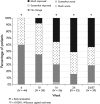Global clinical response in Cushing's syndrome patients treated with mifepristone
- PMID: 24102404
- PMCID: PMC4255292
- DOI: 10.1111/cen.12332
Global clinical response in Cushing's syndrome patients treated with mifepristone
Abstract
Objective: Mifepristone, a glucocorticoid receptor antagonist, improves clinical status in patients with Cushing's syndrome (CS). We examined the pattern, reliability and correlates of global clinical response (GCR) assessments during a 6-month clinical trial of mifepristone in CS.
Design: Post hoc analysis of secondary end-point data from a 24-week multicentre, open-label trial of mifepristone (300-1200 mg daily) in CS. Intraclass correlation coefficient (ICC) was used to examine rater concordance, and drivers of clinical improvement were determined by multivariate regression analysis.
Patients: Forty-six adult patients with refractory CS along with diabetes mellitus type 2 or impaired glucose tolerance, and/or a diagnosis of hypertension.
Measurements: Global clinical assessment made by three independent reviewers using a three-point ordinal scale (+1 = improvement; 0 = no change; -1 = worsening) based on eight broad clinical categories including glucose control, lipids, blood pressure, body composition, clinical appearance, strength, psychiatric/cognitive symptoms and quality of life at Weeks 6, 10, 16, and 24.
Results: Positive GCR increased progressively over time with 88% of patients having improved at Week 24 (P < 0·001). The full concordance among reviewers occurred in 76·6% of evaluations resulting in an ICC of 0·652 (P < 0·001). Changes in body weight (P < 0·0001), diastolic blood pressure (P < 0·0001), two-hour postoral glucose challenge glucose concentration (P = 0·0003), and Cushingoid appearance (P = 0·022) were strong correlates of GCR.
Conclusions: Mifepristone treatment for CS results in progressive clinical improvement. Overall agreement among clinical reviewers was substantial and determinants of positive GCR included change in weight, blood pressure, glucose levels and appearance.
© 2013 The Authors. Clinical Endocrinology published by John Wiley & Sons Ltd.
Figures



Similar articles
-
Mifepristone, a glucocorticoid receptor antagonist, produces clinical and metabolic benefits in patients with Cushing's syndrome.J Clin Endocrinol Metab. 2012 Jun;97(6):2039-49. doi: 10.1210/jc.2011-3350. Epub 2012 Mar 30. J Clin Endocrinol Metab. 2012. PMID: 22466348 Clinical Trial.
-
Sustained weight loss in patients treated with mifepristone for Cushing's syndrome: a follow-up analysis of the SEISMIC study and long-term extension.BMC Endocr Disord. 2015 Oct 27;15:63. doi: 10.1186/s12902-015-0059-5. BMC Endocr Disord. 2015. PMID: 26507877 Free PMC article.
-
The use of the glucocorticoid receptor antagonist mifepristone in Cushing's syndrome.Curr Opin Endocrinol Diabetes Obes. 2012 Aug;19(4):295-9. doi: 10.1097/MED.0b013e32835430bf. Curr Opin Endocrinol Diabetes Obes. 2012. PMID: 22543346 Review.
-
Mifepristone for management of Cushing's syndrome.Pharmacotherapy. 2013 Mar;33(3):319-29. doi: 10.1002/phar.1202. Epub 2013 Feb 21. Pharmacotherapy. 2013. PMID: 23436494 Review.
-
A new therapeutic approach in the medical treatment of Cushing's syndrome: glucocorticoid receptor blockade with mifepristone.Endocr Pract. 2013 Mar-Apr;19(2):313-26. doi: 10.4158/EP12149.RA. Endocr Pract. 2013. PMID: 23337135 Review.
Cited by
-
Medical treatment of Cushing's disease with concurrent diabetes mellitus.Front Endocrinol (Lausanne). 2023 Apr 17;14:1174119. doi: 10.3389/fendo.2023.1174119. eCollection 2023. Front Endocrinol (Lausanne). 2023. PMID: 37139336 Free PMC article. Review.
-
Hormone circuit explains why most HPA drugs fail for mood disorders and predicts the few that work.Mol Syst Biol. 2025 Mar;21(3):254-273. doi: 10.1038/s44320-024-00083-0. Epub 2025 Jan 23. Mol Syst Biol. 2025. PMID: 39849227 Free PMC article.
-
EXPRESSION AND ACTIVITY OF AMINOTRANSFERASES IN THE LIVER OF STREPTOZOTOCIN-DIABETIC RATS: THE EFFECT OF MIFEPRISTONE.Acta Endocrinol (Buchar). 2022 Apr-Jun;18(2):145-149. doi: 10.4183/aeb.2022.145. Acta Endocrinol (Buchar). 2022. PMID: 36212251 Free PMC article.
-
Health-Related Quality of Life in Adrenocortical Carcinoma.Cancers (Basel). 2019 Oct 8;11(10):1500. doi: 10.3390/cancers11101500. Cancers (Basel). 2019. PMID: 31597261 Free PMC article. Review.
-
Evaluation of Evidence of Adrenal Insufficiency in Trials of Normocortisolemic Patients Treated With Mifepristone.J Endocr Soc. 2017 Feb 21;1(4):237-246. doi: 10.1210/js.2016-1097. eCollection 2017 Apr 1. J Endocr Soc. 2017. PMID: 29264481 Free PMC article.
References
-
- Shimon I, Ram Z, Cohen ZR, et al. Transsphenoidal surgery for Cushing’s disease: endocrinological follow-up monitoring of 82 patients. Neurosurgery. 2002;51:57–61. - PubMed
-
- Hammer GD, Tyrrell JB, Lamborn KR, et al. Transsphenoidal microsurgery for Cushing’s disease: initial outcome and long-term results. Journal of Clinical Endocrinology and Metabolism. 2004;89:6348–6357. - PubMed
-
- Atkinson AB, Kennedy A, Wiggam MI, et al. Long-term remission rates after pituitary surgery for Cushing’s disease: the need for long-term surveillance. Clinical Endocrinology. 2005;63:549–559. - PubMed
-
- Tritos NA. Biller BMK. Advances in medical therapies for Cushing’s syndrome. Discovery Medicine. 2012;13:171–179. - PubMed
Publication types
MeSH terms
Substances
LinkOut - more resources
Full Text Sources
Other Literature Sources
Medical

